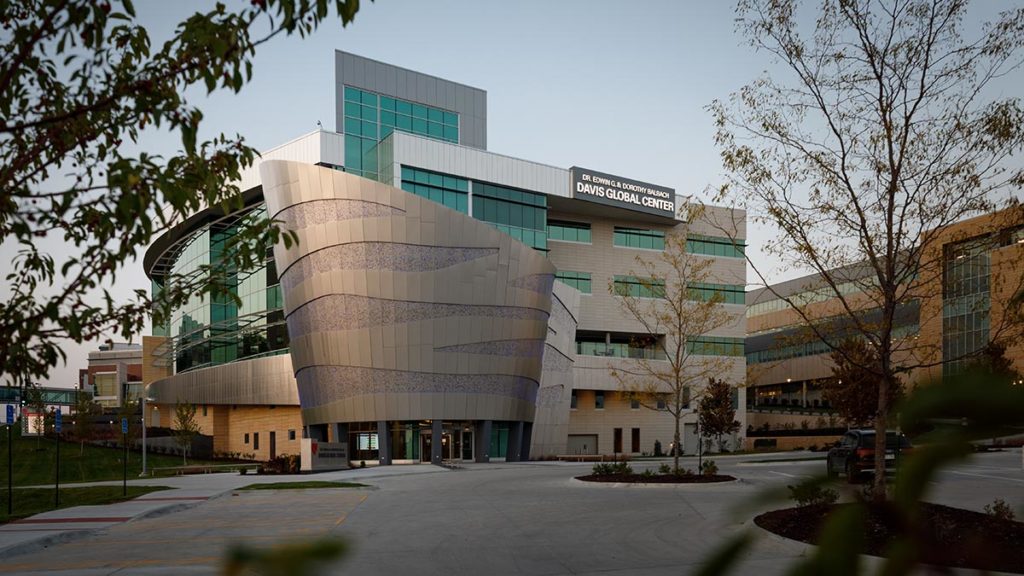Clinical simulation facility to transform health care education


Step inside the Dr. Edwin G. & Dorothy Balbach Davis Global Center on the University of Nebraska Medical Center campus and it’s clear this is not a typical health science building.
Holographic images line the entryway and visitors are dwarfed by the atrium’s three-story high SONY Infinity Wall – the largest display of its kind in the Western Hemisphere – which showcases the caliber of technology innovation offered throughout the facility.
Nearby is the holographic theater – the first in any academic institution in the world – as well as the Laser CAVE-5, a laser-illuminated, five-sided fully immersive room that creates a “full-body” experience for users involving sight, sound, physical movement and interaction.
That’s only a fraction of the innovation – and possibilities – found inside this multi-level, interprofessional clinical simulation center, purposefully designed to create safe, innovative and experiential training environments as well as a venue for innovative research and business development.
On Oct. 13, 2020, the university and community officially celebrated the dedication of this interprofessional simulation facility made possible by public-private partnerships. Due to COVID-19, the ceremony was livestreamed to a global audience. For those who were unable to view the building dedication live, it is posted at unmc.edu.
WATCH: Video celebrates and highlights Davis Global Center’s academics and patient care
“I’ve visited simulation centers around the world, but none compare to UNMC’s Davis Global Center,” said UNMC Chancellor Jeffrey P. Gold, MD. “This facility – and the professionals and technology within it – have been and will continue to be life-changing for the health professionals who train here. This center reshapes the way health care education is delivered for generations to come.”
The state-of-the-art facility houses:
- iEXCEL (Interprofessional Experiential Center for Enduring Learning) – a transformative model for health professions education that incorporates advanced simulation and visualization technologies in realistic, simulated health care settings to improve the outcomes of patient care; and the
- Global Center for Health Security – encompassing biopreparedness training, infectious diseases and high-consequence infections research, education and clinical care.
Nebraskans have long taken pride in strong public-private partnerships, and the Davis Global Center is yet another success story. Funding for the center was provided by the state of Nebraska, city of Omaha and the U.S. federal government. Private support was given by the Dorothy B. Davis Foundation, Mrs. Willa Davis Seemann of Omaha, the William and Ruth Scott Family Foundation, the Suzanne & Walter Scott Foundation and other benefactors.
About the private support received for the project, Brian Hastings, president and CEO of the University of Nebraska Foundation, said, “It took a wonderful team of philanthropic supporters to enable the Davis Global Center to come to fruition. Their vision — their tenaciousness — brought this project to reality, and we cannot thank them enough for what they have done.”
During the dedication, Dr. Gold was joined by Vice Admiral Charles “Chas” Richard, commander of the U.S. Strategic Command in Bellevue, Nebraska; Robert Kadlec, MD, assistant secretary for preparedness and response at the U.S. Department of Health & Human Services; Gen. John E. Hyten, vice chairman of the Joint Chiefs of Staff and most recently, commander at USSTRATCOM; as well as Nebraska Gov. Pete Ricketts and Omaha Mayor Jean Stothert.
Located on UNMC’s Omaha campus, the Davis Global Center serves as the hub for a statewide network of interconnected education centers for faculty in Scottsbluff, Kearney, Norfolk and Lincoln to promote experiential and interactive training opportunities.
“Simulated training improves human performance and ultimately patient care because it enables health care professionals at all levels of training to collaborate as teams and master clinical skills and medical technologies in safe simulated environments,” said Pam Boyers, PhD, associate vice chancellor for clinical simulation and iEXCEL. “At the same time, the facility’s unique design promotes interdisciplinary collaboration, team training and the ability to practice the transfer of care throughout the current health care system.”
iEXCEL also promotes and fosters synergistic relationships between industry, academia, government, military and the community, Dr. Boyers said. Such collaborations yield mutual learning and grant opportunities, specialized training activities, AR/VR and holographic content creation, and new and enhanced products and services.
The current pandemic, she said, already has highlighted the tremendous value of the Davis Global Center. This extraordinary facility with its technology, special design and sufficient space has allowed the medical center to continue providing vital simulation training at a time when it has been most needed.
The 192,000-gross-square-foot building became fully operational in early 2020 and was immediately thrust into the spotlight when the National Quarantine Unit housed and monitored guests from the Diamond Princess cruise ship The 20-bed quarantine unit – the only designated federal quarantine unit in the country – is part of the U.S. Department of Health and Human Services Training, Simulation & Quarantine Center.
“With this purpose-built facility and the synergies between iEXCEL and the Global Center for Health Security, we’re able to systematically help support the federal government and other agencies that need to train health care professionals as well as quarantine individuals with high-risk exposures,” said Chris Kratochvil, MD, executive director of the Global Center for Health Security. “We are all grateful to have a facility such as this that focuses upon safety for individuals as well as communities – and especially our health care professionals who take care of our patients each day.”





